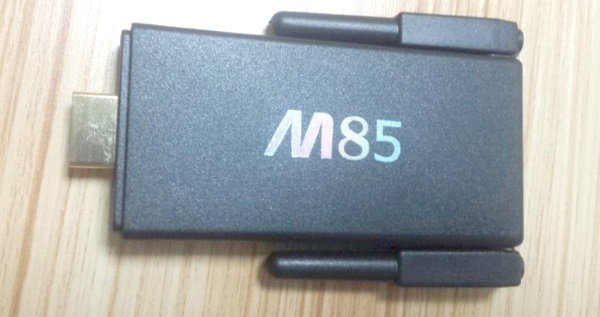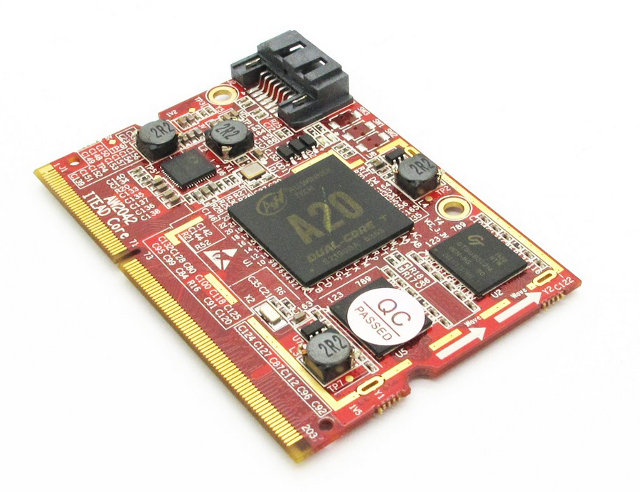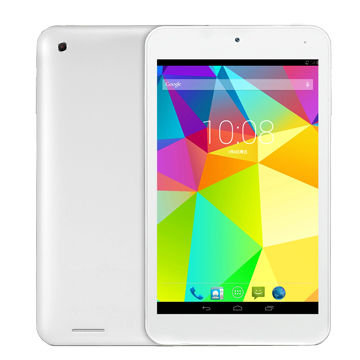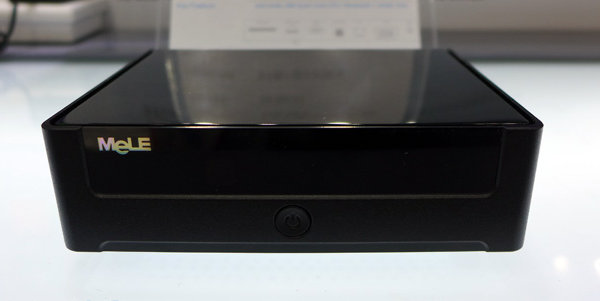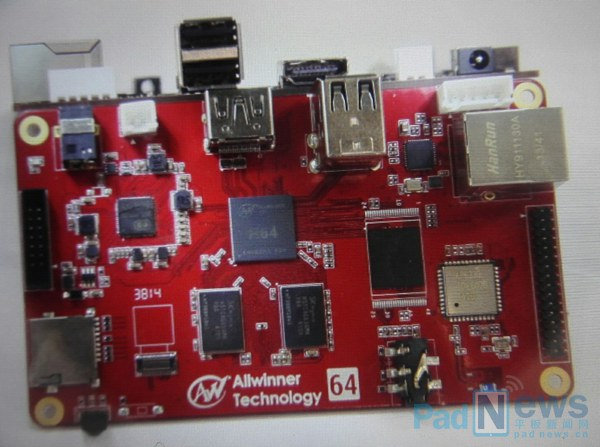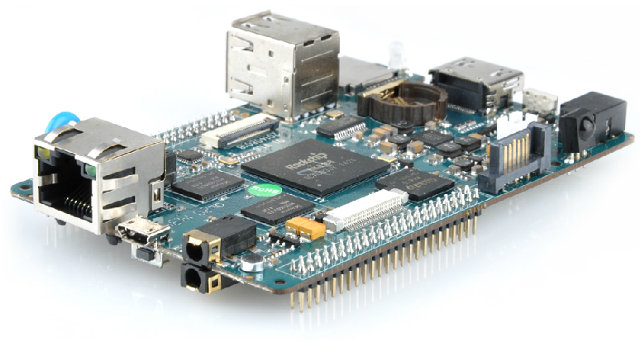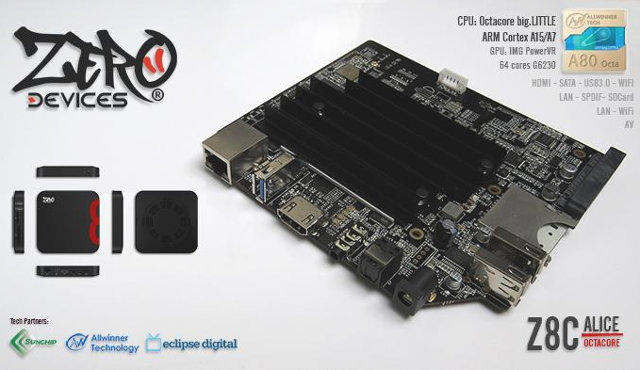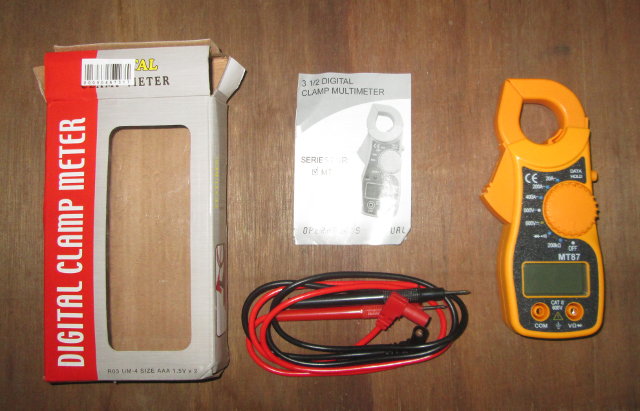We’ve already seen Ugoos S85 board with Amlogic S805 processor for HDMI TV sticks some time ago, and now Android TV dongles based on the low power quad core Cortex A5 processor are finally up for sale, starting with M85 model coming with 1GB RAM, 8GB flash, HDMI and USB ports, and two Wi-Fi antennas. M85 technical specifications: SoC – Amlogic S805 Quad-Core Cortex-A5 @ 1.5GHz with Quad Core ARM Mali-450MP GPU @ 600MHz System Memory – 1GB DDR3 Storage – 8GB NAND FLASH + micro SD card slot Video & Audio Output – HDMI 1.4 up to 1080p Connectivity – 802.11 b/g/n Wi-Fi with two external antennas, Bluetooth. USB – 1x USB 2.0 host port, 2x micro USB ports (1x OTG, 1x for power) Power Supply – DC 5V/2A The device runs Android 4.4. It’s not clear whether any cables or even a power supply are included. I’ve already […]
ITEAD Core AW204X AllWinner A20 SoM and Core EVB Baseboard
ITEAD Studio has been making systems-on-module based on Allwinner processors for a little while which are found in the company’s IBOX mini PC, MOD Duo guitar pedal, and more. They’ve now launched a new system-on-module with a 204-pin SO-DIMM connector instead of the headers used in the earlier modules. ITEAD Core AW2041 / AW2042 SoM specifications: SoC- AllWinner A20 dual core ARM Cortex-A7 @ 1 GHz + ARM Mali 400 MP2 System Memory – 1 or 2 GB DDR3 RAM (AW2014: 1GB, AW2042: 2GB). Storage – 4GB NAND Flash, micro SD card slot (on the back), SATA connector. Connector – 204-pin SO-DIMM edge connector with UART, I2C, SPI, LCD, I2S, LVDS, GPIO, etc.. signals Misc – Built-in RTC, reset, FEL and power buttons. Power – 5V supply, 3.3V I/Os. AXP209 PMIC. Dimensions – 67.60 x 48.25 x 1.6 mm Weight – 35 grams Temperature Range – Commercial To facilitate development, the […]
Cube T7 is a 64-bit ARM Android Tablet Powered by Mediatek MT8752 Octa-core LTE SoC
That’s it! The 64-bit ARM era is upon us! ARMv8 servers have been available to companies for a few months, entry-level 64-bit ARM smartphones such as HTC Desire 510 are coming soon, and so are low cost 64-bit ARM development boards, Nexus 9 tablet leaks (Tegra K1 64-bit) are flooding the blogosphere, and Cube T7 tablet / phablet powered by Mediatek MT8752 octa core Cortex A53 processor will start shipping next month, and is available for pre-order right now for about $200. Cube T7 (preliminary) specifications: SoC – Mediatek MT8752 Octa-core Cortex-A53 Processor @ 1.7 Ghz with Mali T-760 MP2 or T-764 GPU System Memory – 2 GB DDR3L Storage – 16 GB flash + micro SD card slot up to 64 GB Display – 7″ capacitive touchscreen @ 1920×1200. 5 or 10-point multi-touch (TBC) Wireless Connectivity – Dual band WiFi (802.11 b/g/n and ac), Bluetooth 4.0, GPS, A-GPS, FM […]
Mele PCG03 Intel Quad Core mini PC Sells for $49 and Up (Factory Price)
Mele is currently showcasing a mini PC powered by Intel Atom Z3735D quad core processor at the Hong Kong Electronics Fair, and the company has started taking OEM orders for $49 (MOQ 1000) for the barebone model without memory. Mele PCG03 Specifications: SoC – Intel Atom Z3735D “Bay Trail” quad core processor @ 1.33 GHz (Bust freq: 1.83 GHz) with Intel HD graphics System Memory – Optional 1 or 2 GB DDR3 Storage – Optional 16, 32, or 64 GB eMMC + micro SD slot Video Output – HDMI 1.4, VGA and Composite (RCA), Audio I/F – HDMI, Stereo RCA, optical S/PDIF, and MIC and earphone jack. Connectivity – 10/100M Ethernet, 802.11 b/g/n Wi-Fi USB – 2x USB 2.0 host Power Supply – N/A The box will run either Windows 8.1 or Android. I’m a little confused to what “barebone” means for this type of mini PC because the DDR3 […]
Allwinner H64 based Nobel64 Could the First Affordable 64-bit ARM Development Board
Based on the comments I read on this blog many people are early waiting for 64-bit ARM boards. There are already ARMv8 server boards by Applied Micro, AMD and others, but these cost several thousand dollars and are not sold to individuals, and ARM recently launched Juno development board, but it should be well over the budget of most hobbyists too. But the wait may soon be over, as Padnews found out Allwinner and Merrii Technology showcased Nobel64 development board powered by a yet to be announced Allwinner H64 64-bit ARM SoC at the Hong Kong Electronics Fair. Nobel64 development board specifications: SoC – Allwinner H64 quad core 64-bit ARM processor, most probably based on Cortex A53 cores. System Memory – 2GB DDR3 Storage – 16 GB eMMC + micro SD card slot Video / Audio Output – HDMI 1.4 + AV port. Connectivity – Gigabit Ethernet, dual band Wi-Fi, […]
Waxberry Pi3 Rockchip RK3188 Development Board Includes a SATA Port
Development boards based on Rockchip RK3188 are a rarity, and until today, I only knew about Radxa Rock boards. Waxberry, a Chinese based company, already made some development boards such as Waxberry Pi2 based on Rockchip RK3066, and recently they’ve launched Waxberry Pi3 development board powered by Rockchip RK3188 processor, with 1 GB RAM, 8 GB flash, a SATA port, expansion headers and more. Waxberry Pi3 (aka WB-RK3188) specifications: SoC – Rockchip RK3188 ARM Cortex-A9 quad core @ 1.6Ghz + Mali-400 MP4 GPU System Memory – 1GB RAM Storage – 8GB NAND Flash (SK Hynix H27UCG8TETR) + micro-SD slot + SATA port Video Output – HDMI, LVDS connector, and AV output (TBC) Connectivity – 10/100M Ethernet port, 802.11b/g/n WiFi Audio I/O – HDMI, AV?, mic IN Camera – 24-pin CSI connector USB – 2x USB 2.0 host ports, 1x micro USB OTG Misc – IR sensor, RTC with battery slot […]
Allwinner A80 Android TV Boxes Coming Soon, Starting with Zero Devices Z8C Alice
Allwinner A80 based tablets such as Onda V989, and development boards such as A80 OptimusBoard started to ship one to two months ago, but there was absolutly no news about Android mini PCs / media player based on the latest Allwinner processor. This is about to change as ZeroDevices twitted about their Z8C Alice TV Box, apparently designed by Sunchip, and in collaboration with a UK based digital signage company called Eclipse Digital Media. Preliminary technical specifications that we can infer from the picture above: SoC – AllWinner Ultra Core A80 4x Cortex 15, 4x Cortex A7 big.LITTLE processor with Imagination Technologies PowerVR GC6230 GPU with support for OpenGL ES 1.1/2.0/3.0, Directx 9.3 System Memory – N/A Storage – ?? GB eMMC + SD card slot + SATA port (most probably via a USB 2.0/3.0 bridge) Video Output – HDMI + AV port Audio – HDMI, AV, and optical S/PDIF […]
MT87 Digital Clamp Multimeter Hands On
When you want to measure power/current on electrical device, a kill-a-watt is the easiest method, but it’s not always possible for items like air conditioner, water pumps, etc… because they may simply be no plug to disconnect. Luckily, current clamps are made just for this purpose, where you simply place one of the two wires in a clamp / loop, and it magically measures the current. You can’t put both wires inside the loop or measurement will not work at all. The good news is that such devices are very inexpensive, and I bought MT87 digital clamp multimeter, which is also a multimeter adding voltage and resistance measurement capability, for just $11.33 on DealExtreme. MT87 comes with measurement leads (voltage/resistance only), and a user’s manual. The linked user’s manual is not exactly the same document, but very similar, and also refers to MT87C model which adds temperature measurement. There are […]


